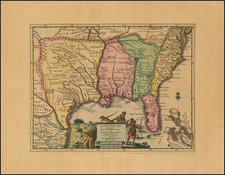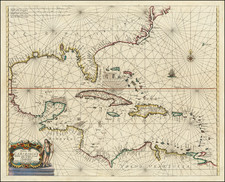Fine example of this rare (unrecorded?) separately issued variant edition of the US Coast Survey map of Key West, Florida, and its approaches, issued during the American Civil War.
Key West was a critically important fortification during the Civil War. Despite the prevailing Rebel sympathies of the local population, the heavily armed fort, controlled by Federal Troops, insured that Key West would remain in the hands of the Union during the entire conflict. The present chart, which is not listed in Stephenson's important cartobibliography on the maps of the Civil War, appears to be the first map of Key West issued during the War, with a second chart of Key West released the following year (Stephenson 117.7).
This important sea chart of Key West and environs includes a large inset map of Key West Harbor and extensive sailing directions. Lithographed by Julius Bien, this edition looks similar to the US Coast Survey's chart of Key West dated 1855, which was engraved by E. Yeager, E.F. Woodears and H.M. Knight, and which appeared in the Coast Survey's Annual Report. However, the two works are apparently from completely different lithographic stones.
For this 1863 edition, separately issued and printed on thick heavy paper, significant information has been added and the currents, Tides and Sailing Directions have been completely revised, with the 4 graphs along the bottom removed from the chart. This Julius Bien edition was only issued separately and never appeared in the Coast Survey's Annual Report, nor does OCLC list any recorded examples of this chart.
A second edition of the 1855 chart was issued in 1864 (again included in the Annual Report), which includes the annotations on the currents directly below the inset map and the Tides below, with a completely different set of sailing directions and new sections on Light Houses, Soundings, and Ranges &c. For Dangers added.
Printed on thick paper and never folded, the chart is in near fine condition.
The United States Coast survey was responsible for several major printing innovations, including electrotyping and photography as applied to cartography. Neither of these technologies were invented within the Coast Survey. However, because of the electrical and mechanical genius of George Mathiot, both of these methods were improved and applied to the rapid production of charts and maps with great effect by the end of the 1850's.
During the Civil War, the trained engineers and hydrographers of the United States Coast Survey played an important role in the production of field maps. While established for hydrographical mapping, at the outset of the War, it became quickly apparent that infrastructure at the Coast Survey office was best suited to the rapid compilation and assimilation of best cartographic sources to produce maps and sea charts in aid of the Union Army and Navy. During this time period, the Coast Survey mapmakers were also responsible for a number of printing innovations that allowed for faster and more accurate printing methods, both at home and in the field. A number of important mapmakers and other historically infuential Americans engaged in the production of maps for the Coast Survey from 1861 to 1865.
The United States Office of the Coast Survey began in 1807, when Thomas Jefferson founded the Survey of the Coast. However, the fledgling office was plagued by the War of 1812 and disagreements over whether it should be civilian or military controlled. The entity was re-founded in 1832 with Ferdinand Rudolph Hassler as its superintendent. Although a civilian agency, many military officers served the office; army officers tended to perform the topographic surveys, while naval officers conducted the hydrographic work.
The Survey’s history was greatly affected by larger events in American history. During the Civil War, while the agency was led by Alexander Dallas Bache (Benjamin Franklin’s grandson), the Survey provided the Union army with charts. Survey personnel accompanied blockading squadrons in the field, making new charts in the process.
After the Civil War, as the country was settled, the Coast Survey sent parties to make new maps, employing scientists and naturalists like John Muir and Louis Agassiz in the process. By 1926, the Survey expanded their purview further to include aeronautical charts. During the Great Depression, the Coast Survey employed over 10,000 people and in the Second World War the office oversaw the production of 100 million maps for the Allies. Since 1970, the Coastal and Geodetic Survey has formed part of the National Oceanic and Atmospheric Administration (NOAA) and it is still producing navigational products and services today.









![[ Florida Native Americans Declaring War ] Bellum denunciandi ratio. XXXIII.](https://storage.googleapis.com/raremaps/img/small/98006.jpg)
![(Florida-Georgia) Wie der Franzosen Oberster eine Seul / daran das Wapen dess Königes auss Franckreich / aussrichten lassen. [How the French commander had a seal made, on which the coat of arms of the King of France is displayed.]](https://storage.googleapis.com/raremaps/img/small/95828.jpg)


![[Florida] Boca y Barra Del Rio Sn. Juan..](https://storage.googleapis.com/raremaps/img/small/43864.jpg)
![[ Death of a Florida Indian Chief ] Ceremoniae in Regis & Sacerdotum funere observatae. XL.](https://storage.googleapis.com/raremaps/img/small/97768.jpg)